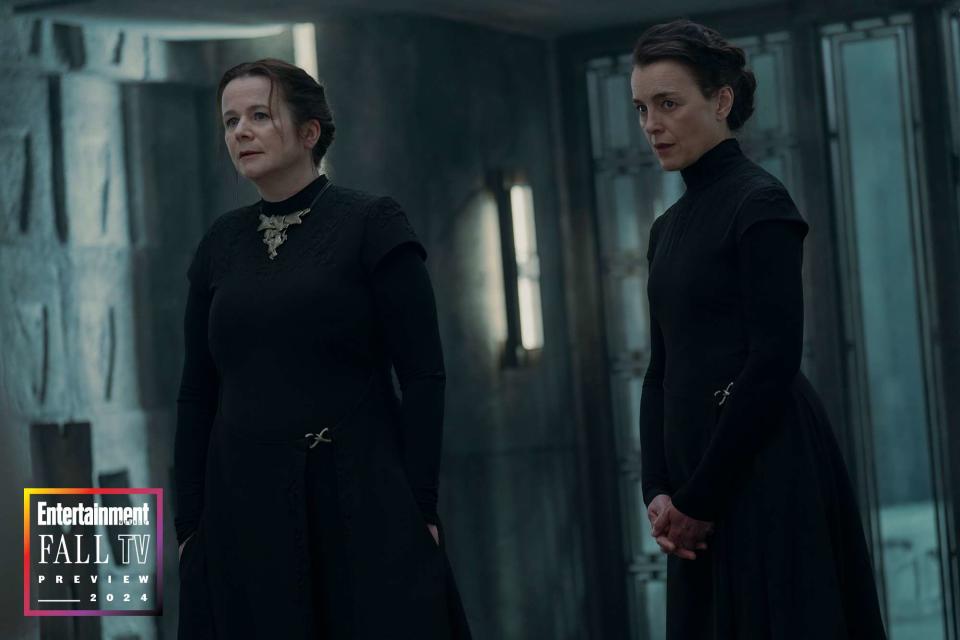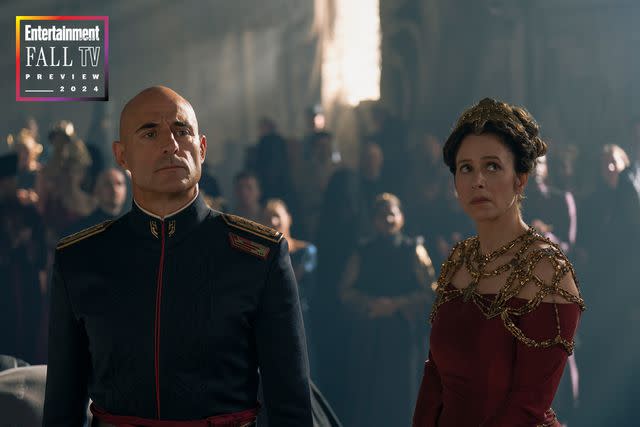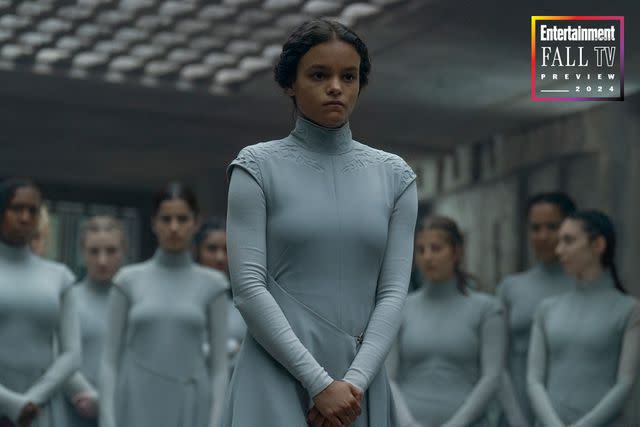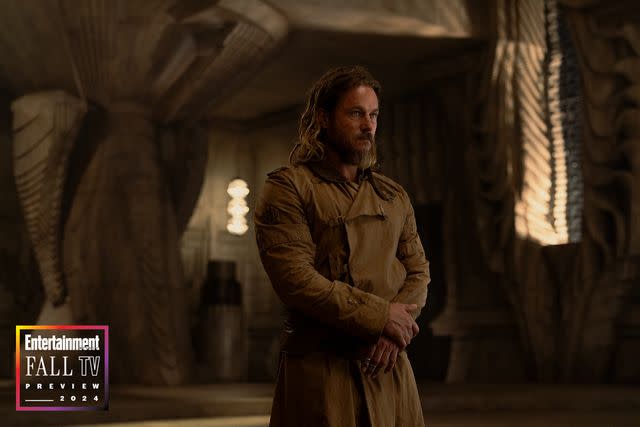How“ Dune: Prophecy” unfolds the secret history of the Bene Gesserit
“We get to see how it all started,” showrunner Alison Schapker tells Entertainment Weekly.

Attila Szvacsek/HBO
Emily Watson and Olivia Williams in 'Dune: Prophecy.'Dune is about a lot of things, but the central narrative of Frank Herbert’s original sci-fi novel and the two Denis Villeneuve film adaptations revolves around Paul Atreides (Timothée Chalamet) and his destiny. But there’s much more to the universe of Dune than Paul alone, and that’s what HBO’s new prequel TV series Dune: Prophecy is going to explore.
The primary focus of the series is the Bene Gesserit, the mystical matriarchal order that will one day manipulate Paul’s rise to power from the shadows. But in this new show, set 10,000 years before Dune proper, the Bene Gesserit is still coming into existence. Two women are the driving force behind its rise to prominence: Valya Harkonnen (Emily Watson) and Tula Harkonnen (Olivia Williams), who are both biological sisters and members of this new sisterhood.

Attila Szvacsek/HBO
Emperor Javicco Corrino (Mark Strong) and Empress Natalya (Jodhi May) in 'Dune: Prophecy.'Related: Doing Dune right: Inside the making of the long-awaited (and star-packed) adaptation
Even the most superficial fan of this franchise should be raising an eyebrow at those names, since the Harkonnen family are the main antagonists of the original Dune story. But in this distant past, the Harkonnens do not yet possess their powerful monopoly on the spice of Arrakis. Instead, they’re reeling from a recent galactic war whose outcome has branded them as cowards and traitors.
“We get to see how it all started,” showrunner Alison Schapker tells Entertainment Weekly during a brief break from post-production, in her first interview about Dune: Prophecy. “When we meet Valya Harkonnen, she is a girl whose family has experienced a tremendous fall from power and has lost its noble status. She dreams of restoring what she feels is rightfully theirs. How she goes from being someone obsessed with rebuilding her noble house to being someone who is dedicated to the Sisterhood above all is a big part of the story. It’s not a girlhood coming-of-age narrative so much as a woman's rise to power from a Harkonnen perspective.”
Sign up for Entertainment Weekly's free daily newsletter to get breaking TV news, exclusive first looks, recaps, reviews, interviews with your favorite stars, and more.
So instead of a young boy trying to become a man, Dune: Prophecy centers around two middle-aged women. Both Williams and Watson really enjoyed getting to delve into the show’s complex sci-fi storytelling.

Attila Szvacsek/HBO
Characters in 'Dune: Prophecy.'“I've never really done anything like this before,” Watson says. “Most of the work I've done so far in my career has been very much based in reality. Getting my head around all the Dune lore and language was a new thing for me. But within that, I found really rich acting territory. It’s quite complex, and it’s a really fun world to play in.”
Dune: Prophecy also marks the first time Williams and Watson have worked together on screen despite being English actors who have crossed paths in various ways over the years. In fact, the way their careers have perfectly dovetailed with this show almost feels like the kind of decades-long master plan at which the Bene Gesserit excels.
“Our careers have run in absolute parallel,” Williams says. “I was at the Royal Shakespeare Company at the same time she was, so we met in the garden of a pub called The Dirty Duck in Stratford-upon-Avon. I think the next time we met was in the parking lot of the Four Seasons in Los Angeles, when she was Oscar-nominated for Breaking the Waves and I was having an amazing period when I made The Postman, Rushmore, and The Sixth Sense in quick succession in the late ‘90s. We’ve bounced in and out of each other's lives, so this was a very exciting opportunity that felt fateful.”

Attila Szvacsek/HBO
Characters in 'Dune: Prophecy.'Thankfully, Williams and Watson didn’t have to worry about sweating their way through the desert sets that stand in for Arrakis in Villeneuve’s movies (which Austin Butler described as a “microwave” in EW’s cover story about Dune: Part Two earlier this year). After all, this show is about how the universe is bigger than just Arrakis, and the Bene Gesserit’s base of operations is elsewhere.
“Everyone I know who’s seen the movies kept asking me, ‘Oh wow, were you in these incredibly hot countries?’ I was like, 'No no no. Our planet is damp and wet,'” Williams says with a laugh. “There was a guy with a water tank on, and he'd pump it and spray everything with water. I basically developed webbed feet by the end of filming this show. But the sets were breathtaking. In particular, the central hall of the Bene Gesserit convent was a modern church built in the ‘70s that had been abandoned in this Hungarian woodland. When you walked onto that set, it took your breath away.”
Herbert wrote five Dune sequel novels (the first of which, Dune Messiah, is definitely on Villeneuve’s radar), but following his death in 1986, his son Brian Herbert and Kevin J. Anderson have co-written a whole multitude of prequel novels that detail the history of this fictional universe. Their book Sisterhood of Dune was the starting point for Dune: Prophecy, but Schapker tells EW that she and her team also took a creative approach to adaptation.

Attila Szvacsek/HBO
Desmond Hart (Travis Fimmel) in 'Dune: Prophecy.'“I really believe that we found the best of both worlds when it comes to adaptation,” Schapker says. “Sisterhood of Dune was our seminal text that we were working with and drawing inspiration from. Our story is tethered to the events in that book, but we also are telling a story that takes place 30 years after the events of the book. So we have both the book to draw from, but we also have room to develop our characters and tell the story of Valya Harkonnen across multiple timelines.”
Yes, you heard that right. Dune: Prophecy’s narrative is split into different time periods, and across all those years, its characters are always cognizant of the past, present, and (as hinted by the title) the future. The Bene Gesserit members who are elevated to the rank of “Reverend Mother” have the unique ability to access the memories of all Reverend Mothers who came before.
“A hallmark of Dune is that time is not just linear,” Schapker says. “Some of them are actively communicating with their female ancestors at any given time. There are hidden histories and secrets to be discovered in the past that very much influenced the present, as our characters design the future. We wanted to create a series that allowed history to be alive, and that meant spending some of our time in the past.”
There are some constants throughout time — this story also has an Emperor (Mark Strong) and an Atreides swordmaster (Chris Mason) – but also new players, like the mysterious Desmond Hart (Travis Fimmel).
In other words, this isn't your typical prequel. Past, present, and future will all intersect and collide when Dune: Prophecy premieres this November on HBO.
Read the original article on Entertainment Weekly.

 Yahoo Lifestyle
Yahoo Lifestyle 
